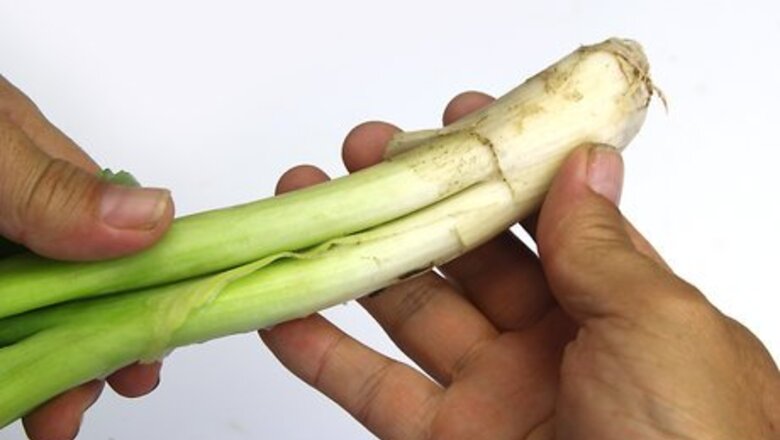
views
Choosing and Storing Leeks

Look for leeks with lots of white and light green. The white and green parts of a leek are called the shank, and this is the edible part of the vegetable. The dark green leaves are tougher and unpleasant to eat, so look for leeks with long shanks.
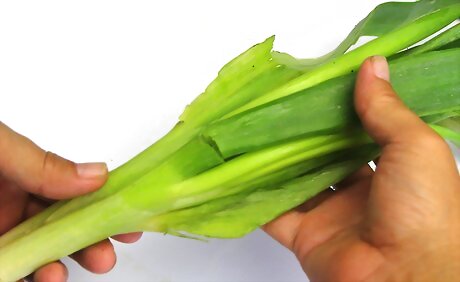
Avoid leeks that are discolored. The shank of the leek should be white and light green, and the upper leaves should be a dark and vibrant green color. Stay away from leeks that are yellowed, bruised, or otherwise discolored.

Choose leeks that are crisp, firm, and fresh. The ideal leek will have a straight shank. It will also be firm instead of soft or mushy, and will look fresh and crisp instead of dry, wilted, or withered. The shank of the leek should also be smooth and unblemished, so avoid leeks that are cracked or split open.

Opt for smaller leeks. Look for small to medium-sized leeks that are no more than 1.5 inches (3.8 cm) in diameter. Larger leeks tend to be tough and more fibrous, and have a woody core that will not soften when you cook it.

Keep leeks in the refrigerator for up to 2 weeks. When you buy leeks that you aren't going to use right away, it's best to keep them chilled until you're ready to use them. Wrap unwashed leeks in a paper towel and transfer them to a sealable plastic bag. Store the leeks in a vegetable drawer to keep them crisp and fresh. Fresh leeks that are stored properly can last for up to two weeks in the refrigerator.
Preparing Leeks
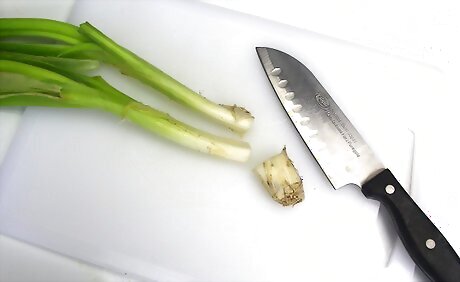
Trim off the roots and dark green leaves. The roots aren't pleasant to eat and the dark green leaves are tough. Use a sharp knife to chop off the ends and tops, but leave as much white and light green on the vegetable as possible. You can keep the roots and dark leaves to make vegetable stock. If you don't have enough vegetable scraps right now, store the roots and leaves in an airtight container and freeze them until you have enough to make the stock.
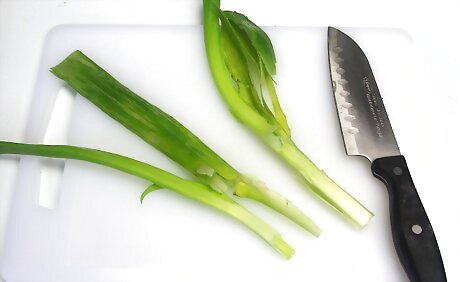
Cut the leek open lengthwise. Transfer the trimmed leek to a cutting board. Use a knife to slice through the middle of the leek, cutting the vegetable open lengthwise. This will allow you to remove dirt that may have collected in the inner layers.
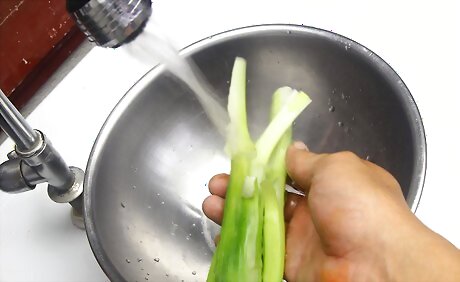
Rinse the leek halves under running water. Peel back the layers of the leek with your fingers. Rinse out dirt and insects that may be hiding inside. Transfer the cleaned leeks to a colander with the darker tips facing down, and allow excess water to drain out for a few minutes.

Chop the leeks as necessary. Some leek recipes require intact leek halves, but most recipes will require you to chop the leeks into half-moon slivers. Place the leeks cut-side down on a cutting board. Hold the leek in place with your fingers, and carefully slice the leek into slivers. Use very thin slivers for garnish, thin slivers for salad, or thicker slivers for soups and stir fries. Intact leek halves are great for baking and roasting, whereas chopped leeks are great for sautéing, frying, adding to soups, and eating raw.
Cooking with Leeks
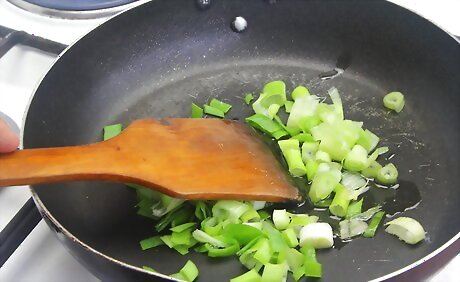
Sauté the leeks to brown them and bring out the flavors. Chop two leeks into thin slivers. In a medium saucepan, combine 1 tablespoon (15 ml)of olive oil and 1 tablespoon (14 g) of butter and heat them over medium heat. When the butter is melted, add the leeks and cook them for about 20 minutes. When the leeks are soft but not browned, remove them from the heat and season them with salt and pepper, to taste. Sautéed leeks are great on their own, or as a topping for salmon, potatoes, and other dishes.
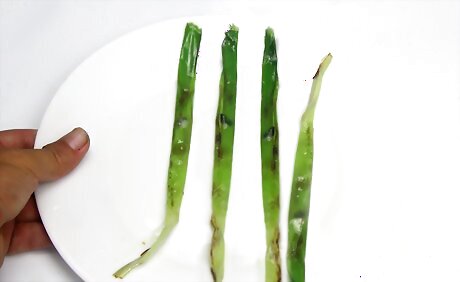
Roast the leeks to cook them slowly and caramelize them slightly. Place a baking sheet in the oven and preheat it to 400 °F (204 °C). Toss 12 leek halves with ½ cup (118 ml) of olive oil and salt, to taste. Remove the pan from the oven and arrange the leek halves cut-side down on the baking sheet. Cover the leeks loosely with foil, reduce the temperature to 300 °F (149 °C), and bake the leeks for about 90 minutes. Remove the foil, increase the temperature back to 400 °F (204 °C), and roast the leeks for another 20 minutes, until golden.

Caramelize them to bring out their sweetness. You can caramelize leeks just like onions. The secret is cooking them for a long time over low heat to bring out the natural sugars. Finely chop a few leek halves and combine them in a frying pan with a butter and oil mixture. Cook the leeks on low for 20 to 40 minutes, adding a few drops of water as necessary to deglaze the pan. Caramelized leeks can be served on toast, served with crackers and cheese, cooked into quiches, or used as a garnish for stews, meats, and savory pies.
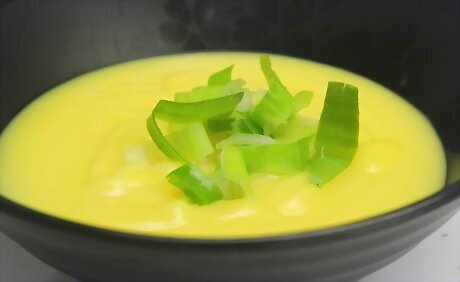
Make a leek and potato soup. Vichyssoise is a thick leek and potato soup that's usually served cold. To make it, sauté leeks and onions in butter until soft, and then add potato slices and chicken stock and cook for an additional 30 minutes. When the potatoes are soft, puree the mixture in a blender and add heavy cream before serving.

Try a leek risotto. Risotto is a creamy rice dish that you can make with vegetables, fish, and meat. In a large saucepan, cook the leeks for about five minutes, until soft. Add the rice and toast it for a minute. Add the warm broth a ladleful at a time, allowing the broth to absorb between additions. Risotto is delicious on its own as a meal, or it can be served as a side with your favorite dishes.
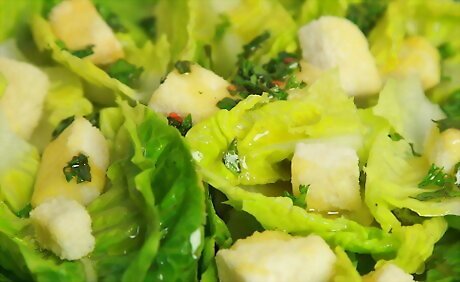
Toss leeks into a salad for a mild onion flavor. Tender, raw leeks are an ideal addition to many different types of salads. For a simple salad, slice a leek half into thin slivers, and toss them with a head of shredded lettuce, a diced cucumber, and a head of lettuce that's been shredded. Drizzle olive oil over the vegetables and toss with salt, pepper, and fresh herbs, to taste.
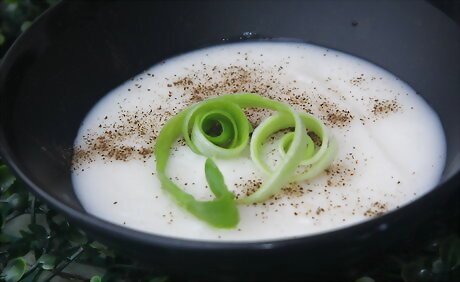
Use leeks raw as a garnish. Small and thin leeks are best for garnish because they are more tender and don't require cooking to soften. Chop a leek half into very thin slivers. Sprinkle the slivers on salads, soups, stews, meats, and other dishes. thank you .




















Comments
0 comment